Chiral Metasurface for Near-Field Imaging and Far-Field Holography Based on Deep Learning
Abstract
1. Introduction
2. Materials and Methods
2.1. Metasurface Structure
2.2. Principles and Formula
3. Results
3.1. Deep Learning Inverse Design of Metasurface Structure
3.2. Near-Field and Holographic Imaging
4. Discussion
Author Contributions
Funding
Data Availability Statement
Conflicts of Interest
References
- Liu, J.; Su, H.; Meng, L.; Zhao, Y.; Deng, C.; Ng, J.C.; Lu, P.; Faisal, M.; Lam, J.W.; Huang, X. What makes efficient circularly polarised luminescence in the condensed phase: Aggregation-induced circular dichroism and light emission. Chem. Sci. 2012, 3, 2737–2747. [Google Scholar] [CrossRef]
- Kuzyk, A.; Schreiber, R.; Fan, Z.; Pardatscher, G.; Roller, E.-M.; Högele, A.; Simmel, F.C.; Govorov, A.O.; Liedl, T. DNA-based self-assembly of chiral plasmonic nanostructures with tailored optical response. Nature 2012, 483, 311–314. [Google Scholar] [CrossRef] [PubMed]
- Le Bel, J.A. Sur les relations qui existent entre les formules atomiques des corps organiques et le pouvoir rotatoire de leurs dissolutions. Bull. Soc. Chim. Fr. 1874, 22, 337–347. [Google Scholar]
- Louis-Jeune, C.; Andrade-Navarro, M.A.; Perez-Iratxeta, C. Prediction of protein secondary structure from circular dichroism using theoretically derived spectra. Proteins Struct. Funct. Bioinform. 2012, 80, 374–381. [Google Scholar] [CrossRef] [PubMed]
- Huang, C.; Feng, Y.; Zhao, J.; Wang, Z.; Jiang, T. Asymmetric electromagnetic wave transmission of linear polarization via polarization conversion through chiral metamaterial structures. Phys. Rev. B 2012, 85, 195131. [Google Scholar] [CrossRef]
- Plum, E.; Zhou, J.; Dong, J.; Fedotov, V.; Koschny, T.; Soukoulis, C.; Zheludev, N. Metamaterial with negative index due to chirality. Phys. Rev. B 2009, 79, 035407. [Google Scholar] [CrossRef]
- Soukoulis, C.M.; Wegener, M. Optical metamaterials—More bulky and less lossy. Science 2010, 330, 1633–1634. [Google Scholar] [CrossRef]
- Kadic, M.; Milton, G.W.; van Hecke, M.; Wegener, M. 3D metamaterials. Nat. Rev. Phys. 2019, 1, 198–210. [Google Scholar] [CrossRef]
- Zhu, A.Y.; Chen, W.T.; Zaidi, A.; Huang, Y.-W.; Khorasaninejad, M.; Sanjeev, V.; Qiu, C.-W.; Capasso, F. Giant intrinsic chiro-optical activity in planar dielectric nanostructures. Light Sci. Appl. 2018, 7, 17158. [Google Scholar] [CrossRef]
- Mueller, J.B.; Rubin, N.A.; Devlin, R.C.; Groever, B.; Capasso, F. Metasurface polarization optics: Independent phase control of arbitrary orthogonal states of polarization. Phys. Rev. Lett. 2017, 118, 113901. [Google Scholar] [CrossRef]
- Wang, Q.; Plum, E.; Yang, Q.; Zhang, X.; Xu, Q.; Xu, Y.; Han, J.; Zhang, W. Reflective chiral meta-holography: Multiplexing holograms for circularly polarized waves. Light Sci. Appl. 2018, 7, 25. [Google Scholar] [CrossRef]
- Tseng, M.L.; Jahani, Y.; Leitis, A.; Altug, H. Dielectric metasurfaces enabling advanced optical biosensors. ACS Photonics 2020, 8, 47–60. [Google Scholar] [CrossRef]
- Yoo, S.; Park, Q.-H. Metamaterials and chiral sensing: A review of fundamentals and applications. Nanophotonics 2019, 8, 249–261. [Google Scholar] [CrossRef]
- Fan, J.; Cheng, Y. Broadband high-efficiency cross-polarization conversion and multi-functional wavefront manipulation based on chiral structure metasurface for terahertz wave. J. Phys. D Appl. Phys. 2019, 53, 025109. [Google Scholar] [CrossRef]
- Gabor, D. A New Microscopi Prinnciple. Nature 1948, 161, 777–778. [Google Scholar] [CrossRef]
- Huntington, M.D.; Lauhon, L.J.; Odom, T.W. Subwavelength lattice optics by evolutionary design. Nano Lett. 2014, 14, 7195–7200. [Google Scholar] [CrossRef] [PubMed]
- Molesky, S.; Lin, Z.; Piggott, A.Y.; Jin, W.; Vucković, J.; Rodriguez, A.W. Inverse design in nanophotonics. Nat. Photonics 2018, 12, 659–670. [Google Scholar] [CrossRef]
- Li, W.; Meng, F.; Chen, Y.; Li, Y.f.; Huang, X. Topology optimization of photonic and phononic crystals and metamaterials: A review. Adv. Theory Simul. 2019, 2, 1900017. [Google Scholar] [CrossRef]
- Kao, C.Y.; Osher, S.; Yablonovitch, E. Maximizing band gaps in two-dimensional photonic crystals by using level set methods. Appl. Phys. B 2005, 81, 235–244. [Google Scholar] [CrossRef]
- Schmidhuber, J. Deep learning in neural networks: An overview. Neural Netw. 2015, 61, 85–117. [Google Scholar] [CrossRef]
- Nadell, C.C.; Huang, B.; Malof, J.M.; Padilla, W.J. Deep learning for accelerated all-dielectric metasurface design. Opt. Express 2019, 27, 27523–27535. [Google Scholar] [CrossRef] [PubMed]
- Qiu, T.; Shi, X.; Wang, J.; Li, Y.; Qu, S.; Cheng, Q.; Cui, T.; Sui, S. Deep learning: A rapid and efficient route to automatic metasurface design. Adv. Sci. 2019, 6, 1900128. [Google Scholar] [CrossRef] [PubMed]
- Shi, J.; Yan, P.; Zhou, L.; Wang, Z.; Chen, Z.; Zhang, X. Rapid all-in-focus imaging via physical neural network optical encoding. Opt. Lasers Eng. 2023, 164, 107520. [Google Scholar] [CrossRef]
- Shi, J.; Chen, Y.; Zhang, X. A Broad-Spectrum Diffractive Network via Ensemble Learning. arXiv 2021, arXiv:2110.08267. [Google Scholar] [CrossRef] [PubMed]
- So, S.; Badloe, T.; Noh, J.; Bravo-Abad, J.; Rho, J. Deep learning enabled inverse design in nanophotonics. Nanophotonics 2020, 9, 1041–1057. [Google Scholar] [CrossRef]
- Mirza, M.; Osindero, S. Conditional generative adversarial nets. arXiv 2014, arXiv:1411.1784. [Google Scholar]
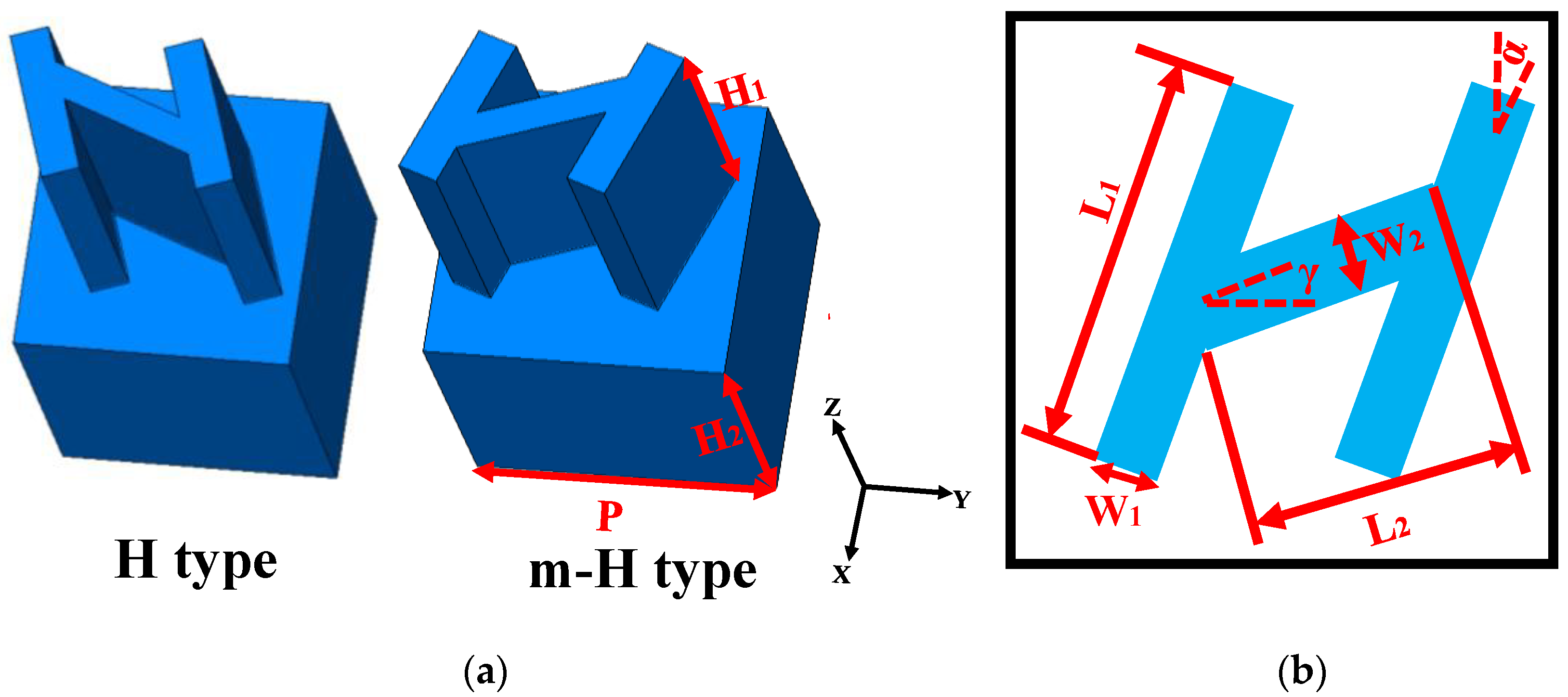
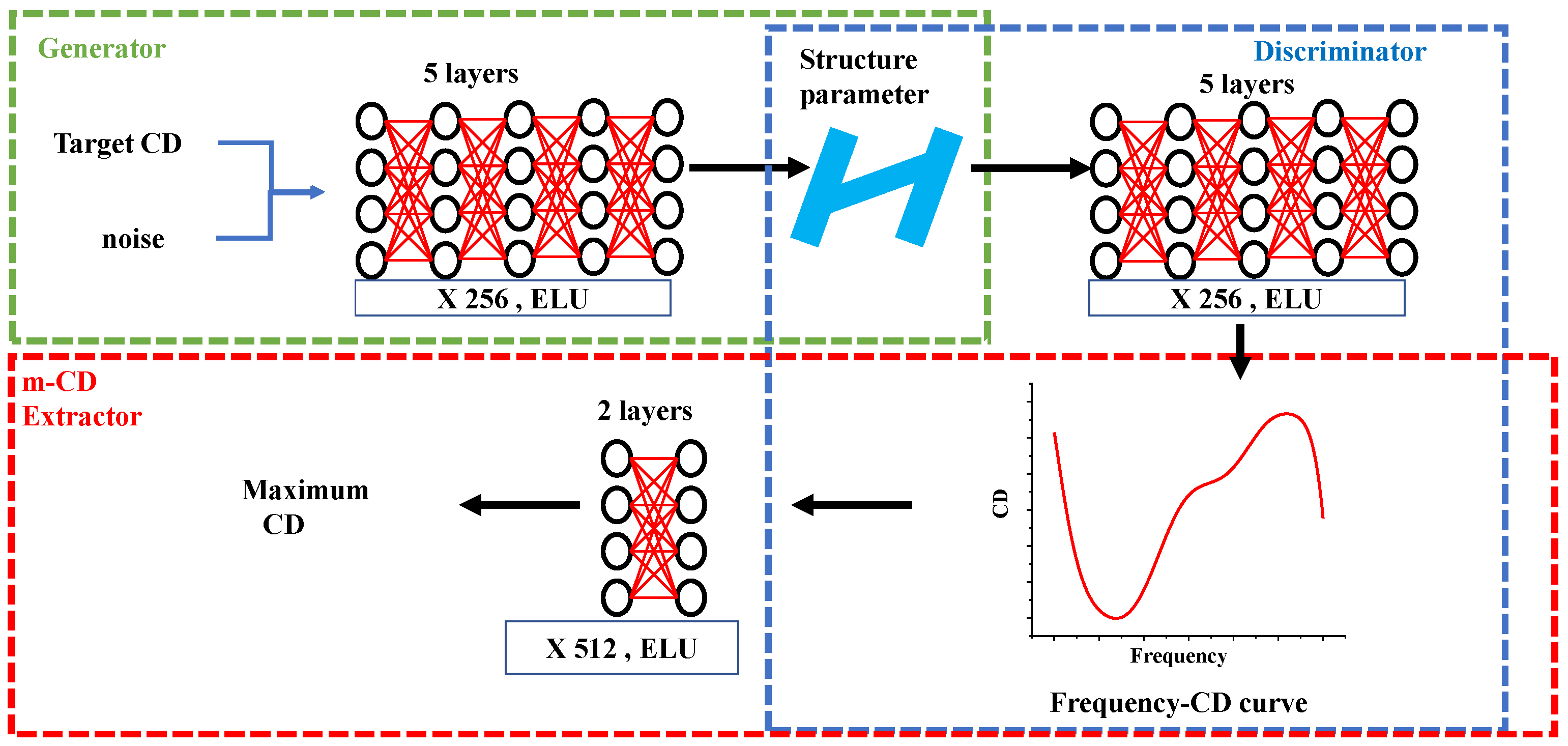
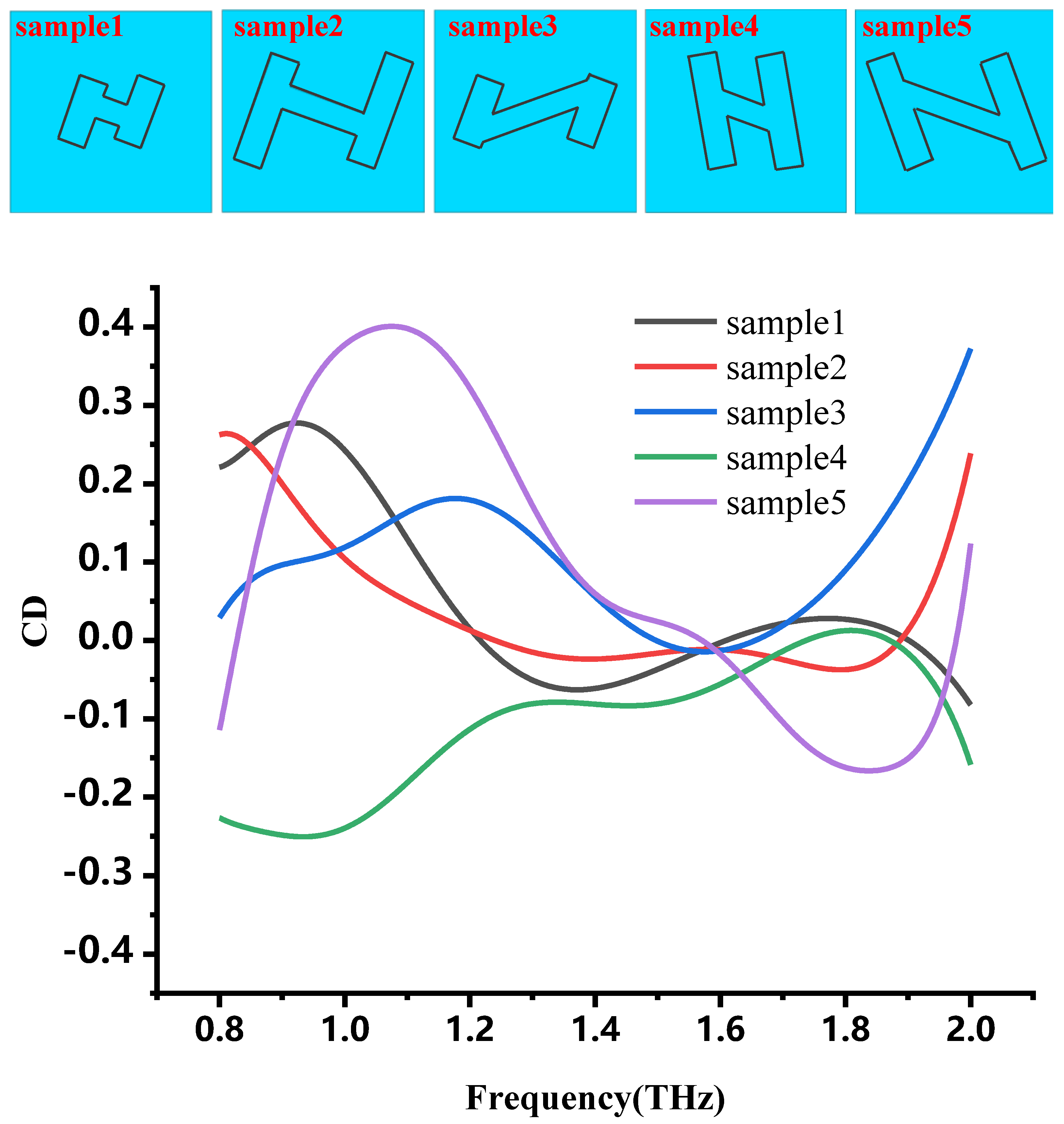


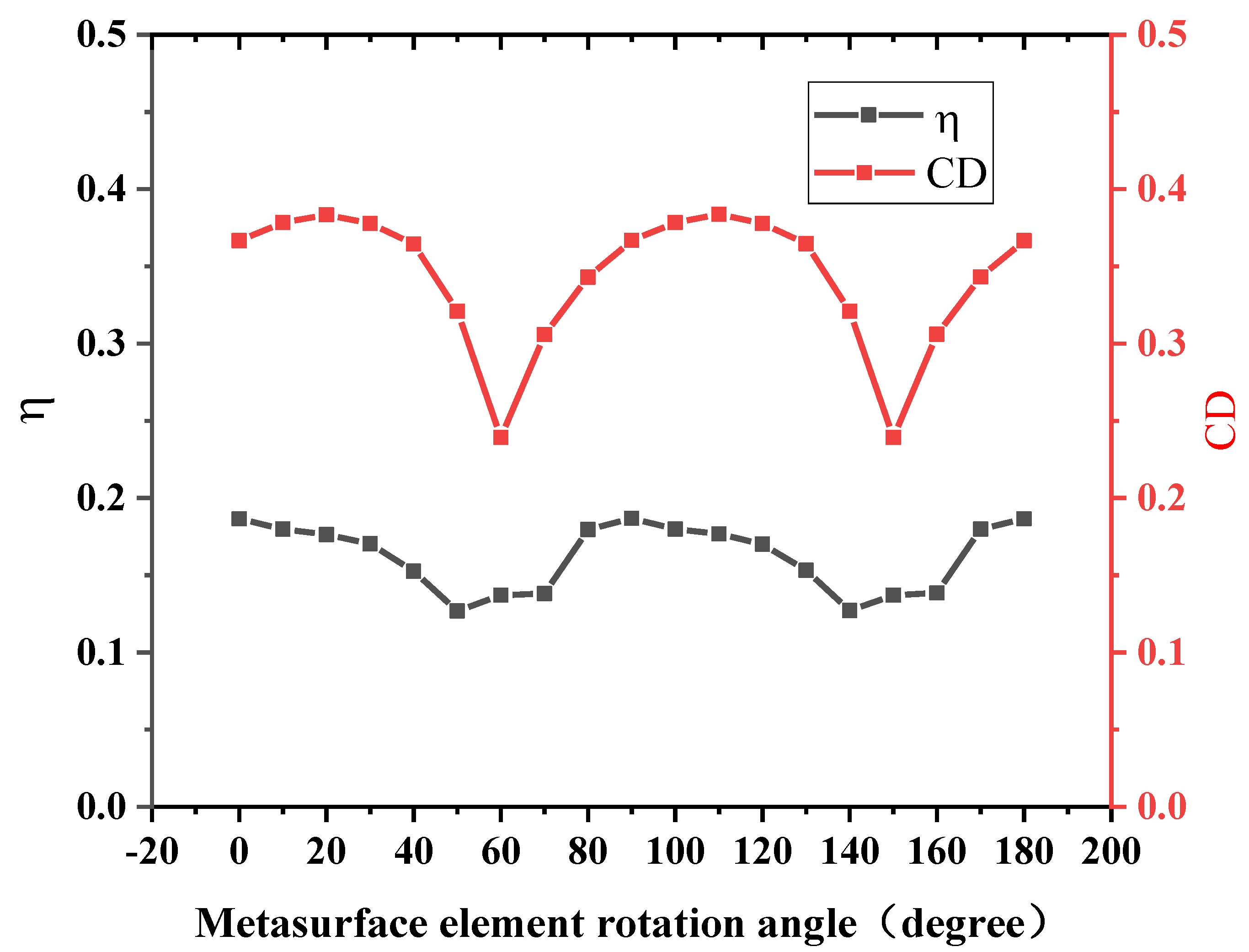

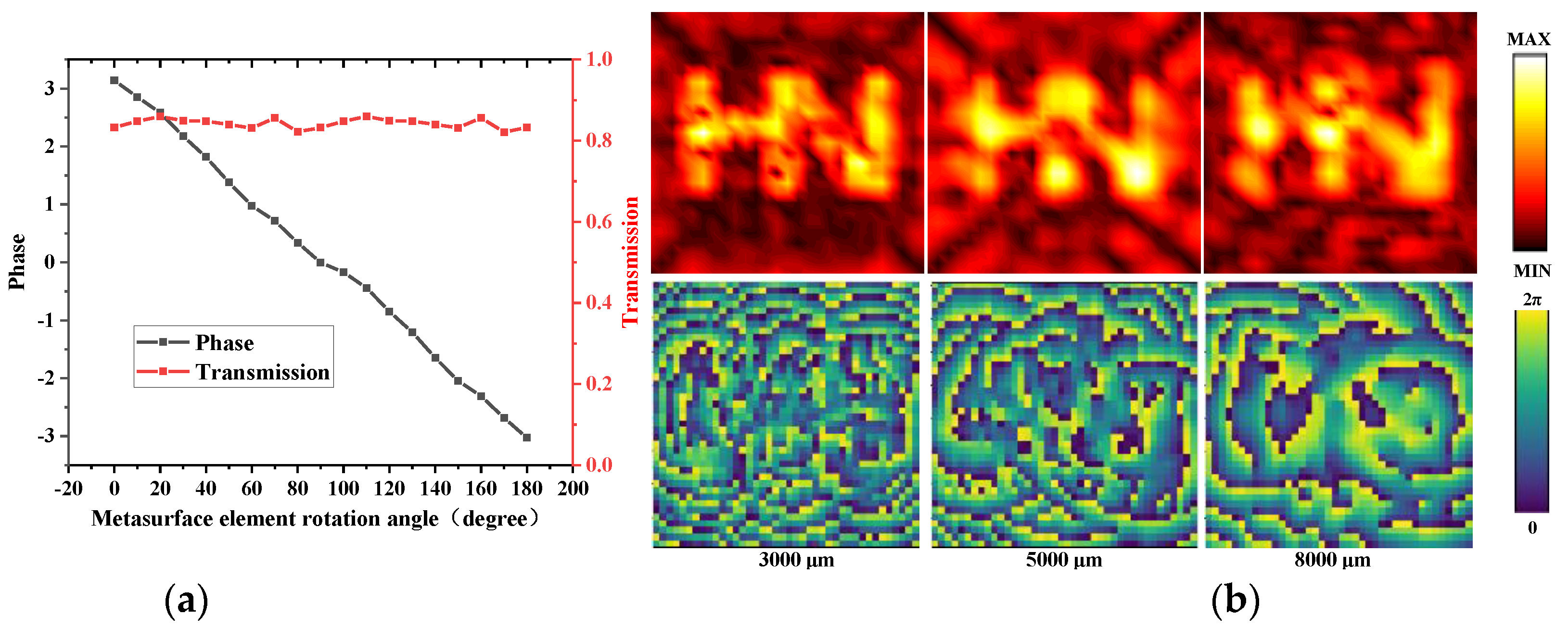
| α (Degree) | γ (Degree) | L1 (μm) | L2 (μm) | |
|---|---|---|---|---|
| sample 1 | −20 | −20 | 60 | 50 |
| sample 2 | −20 | −20 | 100 | 100 |
| sample 3 | −20 | 20 | 60 | 100 |
| sample 4 | 10 | −20 | 100 | 60 |
| sample 5 | 20 | −20 | 100 | 100 |
Disclaimer/Publisher’s Note: The statements, opinions and data contained in all publications are solely those of the individual author(s) and contributor(s) and not of MDPI and/or the editor(s). MDPI and/or the editor(s) disclaim responsibility for any injury to people or property resulting from any ideas, methods, instructions or products referred to in the content. |
© 2023 by the authors. Licensee MDPI, Basel, Switzerland. This article is an open access article distributed under the terms and conditions of the Creative Commons Attribution (CC BY) license (https://creativecommons.org/licenses/by/4.0/).
Share and Cite
Qiu, Y.; Chen, S.; Hou, Z.; Wang, J.; Shen, J.; Li, C. Chiral Metasurface for Near-Field Imaging and Far-Field Holography Based on Deep Learning. Micromachines 2023, 14, 789. https://doi.org/10.3390/mi14040789
Qiu Y, Chen S, Hou Z, Wang J, Shen J, Li C. Chiral Metasurface for Near-Field Imaging and Far-Field Holography Based on Deep Learning. Micromachines. 2023; 14(4):789. https://doi.org/10.3390/mi14040789
Chicago/Turabian StyleQiu, Yihang, Sixue Chen, Zheyu Hou, Jingjing Wang, Jian Shen, and Chaoyang Li. 2023. "Chiral Metasurface for Near-Field Imaging and Far-Field Holography Based on Deep Learning" Micromachines 14, no. 4: 789. https://doi.org/10.3390/mi14040789
APA StyleQiu, Y., Chen, S., Hou, Z., Wang, J., Shen, J., & Li, C. (2023). Chiral Metasurface for Near-Field Imaging and Far-Field Holography Based on Deep Learning. Micromachines, 14(4), 789. https://doi.org/10.3390/mi14040789






